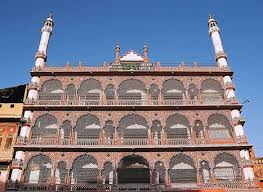
Nestled in the Pali district of Rajasthan, the Nabi Qadi Hamid al-din Mosque is an ancient architectural jewel, captivating visitors with its historic charm and intricate design. Built during the late 13th century or early 14th century by Sultan al-Tarikin, this mosque offers a glimpse into the splendor of the Khilji Dynasty. The craftsmanship of its columns and arches resonates with the architectural styles later mirrored in Gujarat and Nagaur, standing as one of the oldest and most significant Islamic monuments in the region. Architectural Grace and Legacy At the heart of the Kharadi area, the Nabi Qadi Hamid al-din Mosque reveals a stunning flat-roofed, columned prayer hall measuring 5 x 10 meters. The hall features two aisles and five inlets, leading to a serene courtyard on the eastern side. The central bay, slightly wider than the others, adds balance to the design, while the slimmer side bays lend elegance to the overall structure. The columns of the mosque—simple, narrow shafts measuring 25 x 25 cm—are a highlight of the Khilji-inspired design, showcasing a style that spread across 14th and 15th-century Gujarat. The mihrab, a central element of prayer halls, projects beautifully from the rear wall. It features an ogee arch on stone pilasters and is framed by roundels in the spandrels, reflecting similarities with the Makhdum Husain Mosque. A minar with three stone steps stands to the north of the mihrab, while two windows on the northern wall filter light into the prayer space. Over the centuries, this historic mosque has undergone several renovations, including the 17th-century addition of a flat roof, eave stones, and parapet walls. More recently, a chamber was added to the southwest corner, and a graceful arch now joins the columns in that section. Though modern elements blend with the original design, the essence of its Khilji-era heritage remains untouched. Historic Inscription of Shah Jahan’s Era Above the mihrab lies a Persian inscription, etched in elegant prose, dated 2nd Dhu'l-Hijja 1047 (17th April). This inscription from the reign of Mughal emperor Shah Jahan marks the mosque's restoration, crediting Sultan al-Tarikin Qadi Hamid al-din Nagauri as its founder. This detail cements the mosque's position as one of the earliest Islamic monuments in Nagaur, reflecting a fascinating intersection of Khilji-era design and Mughal patronage. The site remains a living heritage space, offering visitors an opportunity to witness an era where history, faith, and art converge. A Journey Through Time Stepping into the Nabi Qadi Hamid al-din Mosque is like entering a time capsule. The worn yet graceful columns, the intricate mihrab, and the tranquil courtyard evoke stories of an age when art flourished under imperial patronage. Whether you are an architecture enthusiast, a history lover, or simply a curious traveler, this mosque offers a profound connection to the Islamic and cultural heritage of Rajasthan. With its Khilji-inspired design and echoes of Mughal history, the mosque is not just a place of worship but a testament to the architectural brilliance of a bygone era. A visit to this monument is a journey through centuries of history, leaving visitors in awe of its timeless